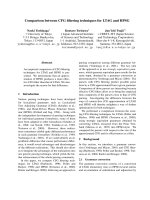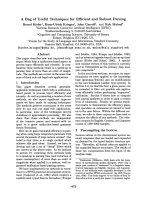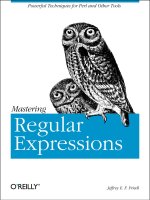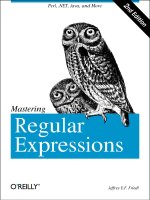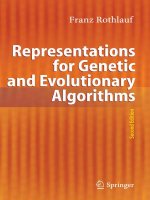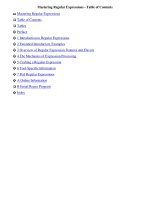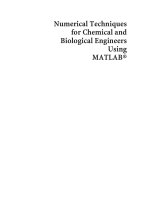0596002890 {1495a44a} mastering regular expressions powerful techniques for perl and other tools (2nd ed ) friedl 2002 07 15
Bạn đang xem bản rút gọn của tài liệu. Xem và tải ngay bản đầy đủ của tài liệu tại đây (6.16 MB, 474 trang )
Powerful Techniques for Perl and Other Tools
Mastering
Regular
Expressions
Jeffrey E. F. Friedl
Table of Contents
Preface ..................................................................................................................... xv
1: Introduction to Regular Expressions ...................................................... 1
Solving Real Problems ........................................................................................ 2
Regular Expressions as a Language ................................................................... 4
The Filename Analogy ................................................................................. 4
The Language Analogy ................................................................................ 5
The Regular-Expression Frame of Mind ............................................................ 6
If You Have Some Regular-Expression Experience ................................... 6
Searching Text Files: Egrep ......................................................................... 6
Egrep Metacharacters .......................................................................................... 8
Start and End of the Line ............................................................................. 8
Character Classes .......................................................................................... 9
Matching Any Character with Dot ............................................................. 11
Alternation .................................................................................................. 13
Ignoring Differences in Capitalization ...................................................... 14
Word Boundaries ........................................................................................ 15
In a Nutshell ............................................................................................... 16
Optional Items ............................................................................................ 17
Other Quantifiers: Repetition .................................................................... 18
Parentheses and Backreferences ............................................................... 20
The Great Escape ....................................................................................... 22
Expanding the Foundation ............................................................................... 23
Linguistic Diversification ............................................................................ 23
The Goal of a Regular Expression ............................................................ 23
vii
5 May 2003 08:41
viii
Table of Contents
A Few More Examples ...............................................................................
Regular Expression Nomenclature ............................................................
Improving on the Status Quo ....................................................................
Summary .....................................................................................................
Personal Glimpses ............................................................................................
23
27
30
32
33
2: Extended Introductory Examples .......................................................... 35
About the Examples ..........................................................................................
A Short Introduction to Perl ......................................................................
Matching Text with Regular Expressions .........................................................
Toward a More Real-World Example ........................................................
Side Effects of a Successful Match ............................................................
Intertwined Regular Expressions ...............................................................
Intermission ................................................................................................
Modifying Text with Regular Expressions .......................................................
Example: Form Letter .................................................................................
Example: Prettifying a Stock Price ............................................................
Automated Editing ......................................................................................
A Small Mail Utility .....................................................................................
Adding Commas to a Number with Lookaround .....................................
Text-to-HTML Conversion ...........................................................................
That Doubled-Word Thing .........................................................................
36
37
38
40
40
43
49
50
50
51
53
53
59
67
77
3: Overview of Regular Expression Features and Flavors ................ 83
A Casual Stroll Across the Regex Landscape ................................................... 85
The Origins of Regular Expressions .......................................................... 85
At a Glance ................................................................................................. 91
Care and Handling of Regular Expressions ..................................................... 93
Integrated Handling ................................................................................... 94
Procedural and Object-Oriented Handling ............................................... 95
A Search-and-Replace Example ................................................................. 97
Search and Replace in Other Languages .................................................. 99
Care and Handling: Summary ................................................................. 101
Strings, Character Encodings, and Modes ...................................................... 101
Strings as Regular Expressions ................................................................ 101
Character-Encoding Issues ....................................................................... 105
Regex Modes and Match Modes .............................................................. 109
Common Metacharacters and Features .......................................................... 112
Character Representations ....................................................................... 114
5 May 2003 08:41
Table of Contents
Character Classes and Class-Like Constructs ..........................................
Anchors and Other “Zero-Width Assertions” ..........................................
Comments and Mode Modifiers ..............................................................
Grouping, Capturing, Conditionals, and Control ...................................
Guide to the Advanced Chapters ...................................................................
ix
117
127
133
135
141
4: The Mechanics of Expression Processing .......................................... 143
Start Your Engines! ..........................................................................................
Two Kinds of Engines ..............................................................................
New Standards ..........................................................................................
Regex Engine Types .................................................................................
From the Department of Redundancy Department ................................
Testing the Engine Type ..........................................................................
Match Basics ....................................................................................................
About the Examples .................................................................................
Rule 1: The Match That Begins Earliest Wins .........................................
Engine Pieces and Parts ...........................................................................
Rule 2: The Standard Quantifiers Are Greedy ........................................
Regex-Directed Versus Text-Directed ............................................................
NFA Engine: Regex-Directed ....................................................................
DFA Engine: Text-Directed .......................................................................
First Thoughts: NFA and DFA in Comparison ..........................................
Backtracking ....................................................................................................
A Really Crummy Analogy .......................................................................
Two Important Points on Backtracking ..................................................
Saved States ..............................................................................................
Backtracking and Greediness ..................................................................
More About Greediness and Backtracking ....................................................
Problems of Greediness ...........................................................................
Multi-Character “Quotes” .........................................................................
Using Lazy Quantifiers .............................................................................
Greediness and Laziness Always Favor a Match ....................................
The Essence of Greediness, Laziness, and Backtracking .......................
Possessive Quantifiers and Atomic Grouping ........................................
Possessive Quantifiers, ?+, ++, ++, and {m,n}+ .........................................
The Backtracking of Lookaround ............................................................
Is Alternation Greedy? ..............................................................................
Taking Advantage of Ordered Alternation ..............................................
NFA, DFA, and POSIX .......................................................................................
5 May 2003 08:41
143
144
144
145
146
146
147
147
148
149
151
153
153
155
156
157
158
159
159
162
163
164
165
166
167
168
169
172
173
174
175
177
x
Table of Contents
“The Longest-Leftmost” ............................................................................
POSIX and the Longest-Leftmost Rule .....................................................
Speed and Efficiency ................................................................................
Summary: NFA and DFA in Comparison ..................................................
Summary ..........................................................................................................
177
178
179
180
183
5: Practical Regex Techniques .................................................................... 185
Regex Balancing Act .......................................................................................
A Few Short Examples ....................................................................................
Continuing with Continuation Lines .......................................................
Matching an IP Address ...........................................................................
Working with Filenames ..........................................................................
Matching Balanced Sets of Parentheses ..................................................
Watching Out for Unwanted Matches .....................................................
Matching Delimited Text ..........................................................................
Knowing Your Data and Making Assumptions ......................................
Stripping Leading and Trailing Whitespace ............................................
HTML-Related Examples ..................................................................................
Matching an HTML Tag .............................................................................
Matching an HTML Link ............................................................................
Examining an HTTP URL ..........................................................................
Validating a Hostname .............................................................................
Plucking Out a URL in the Real World ....................................................
Extended Examples ........................................................................................
Keeping in Sync with Your Data .............................................................
Parsing CSV Files ......................................................................................
186
186
186
187
190
193
194
196
198
199
200
200
201
203
203
205
208
208
212
6: Crafting an Efficient Expression ........................................................... 221
A Sobering Example .......................................................................................
A Simple Change — Placing Your Best Foot Forward .............................
Efficiency Verses Correctness ..................................................................
Advancing Further — Localizing the Greediness .....................................
Reality Check ............................................................................................
A Global View of Backtracking ......................................................................
More Work for a POSIX NFA .....................................................................
Work Required During a Non-Match ......................................................
Being More Specific .................................................................................
Alternation Can Be Expensive .................................................................
Benchmarking .................................................................................................
5 May 2003 08:41
222
223
223
225
226
228
229
230
231
231
232
Table of Contents
Know What You’re Measuring .................................................................
Benchmarking with Java ..........................................................................
Benchmarking with VB.NET ....................................................................
Benchmarking with Python .....................................................................
Benchmarking with Ruby ........................................................................
Benchmarking with Tcl ............................................................................
Common Optimizations ..................................................................................
No Free Lunch ..........................................................................................
Everyone’s Lunch is Different ..................................................................
The Mechanics of Regex Application ......................................................
Pre-Application Optimizations .................................................................
Optimizations with the Transmission ......................................................
Optimizations of the Regex Itself ............................................................
Techniques for Faster Expressions .................................................................
Common Sense Techniques ....................................................................
Expose Literal Text ...................................................................................
Expose Anchors ........................................................................................
Lazy Versus Greedy: Be Specific .............................................................
Split Into Multiple Regular Expressions ..................................................
Mimic Initial-Character Discrimination ....................................................
Use Atomic Grouping and Possessive Quantifiers .................................
Lead the Engine to a Match .....................................................................
Unrolling the Loop ..........................................................................................
Method 1: Building a Regex From Past Experiences .............................
The Real “Unrolling-the-Loop” Pattern ...................................................
Method 2: A Top-Down View .................................................................
Method 3: An Internet Hostname ............................................................
Observations .............................................................................................
Using Atomic Grouping and Possessive Quantifiers ..............................
Short Unrolling Examples ........................................................................
Unrolling C Comments ............................................................................
The Freeflowing Regex ...................................................................................
A Helping Hand to Guide the Match ......................................................
A Well-Guided Regex is a Fast Regex .....................................................
Wrapup .....................................................................................................
In Summary: Think! ........................................................................................
5 May 2003 08:41
xi
234
234
236
237
238
239
239
240
240
241
242
245
247
252
254
255
255
256
257
258
259
260
261
262
263
266
267
268
268
270
272
277
277
279
280
281
xii
Table of Contents
7: Perl ................................................................................................................... 283
Regular Expressions as a Language Component ...........................................
Perl’s Greatest Strength ............................................................................
Perl’s Greatest Weakness .........................................................................
Perl’s Regex Flavor ..........................................................................................
Regex Operands and Regex Literals .......................................................
How Regex Literals Are Parsed ...............................................................
Regex Modifiers ........................................................................................
Regex-Related Perlisms ...................................................................................
Expression Context ..................................................................................
Dynamic Scope and Regex Match Effects ...............................................
Special Variables Modified by a Match ...................................................
The qr/˙˙˙/ Operator and Regex Objects ........................................................
Building and Using Regex Objects ..........................................................
Viewing Regex Objects ............................................................................
Using Regex Objects for Efficiency .........................................................
The Match Operator ........................................................................................
Match’s Regex Operand ...........................................................................
Specifying the Match Target Operand .....................................................
Different Uses of the Match Operator .....................................................
Iterative Matching: Scalar Context, with /g .............................................
The Match Operator’s Environmental Relations .....................................
The Substitution Operator ..............................................................................
The Replacement Operand ......................................................................
The /e Modifier ........................................................................................
Context and Return Value ........................................................................
The Split Operator ..........................................................................................
Basic Split .................................................................................................
Returning Empty Elements ......................................................................
Split’s Special Regex Operands ...............................................................
Split’s Match Operand with Capturing Parentheses ...............................
Fun with Perl Enhancements .........................................................................
Using a Dynamic Regex to Match Nested Pairs .....................................
Using the Embedded-Code Construct .....................................................
Using local in an Embedded-Code Construct .....................................
A Warning About Embedded Code and my Variables ............................
Matching Nested Constructs with Embedded Code ...............................
Overloading Regex Literals ......................................................................
Problems with Regex-Literal Overloading ..............................................
5 May 2003 08:41
285
286
286
286
288
292
292
293
294
295
299
303
303
305
306
306
307
308
309
312
316
318
319
319
321
321
322
324
325
326
326
328
331
335
338
340
341
344
Table of Contents
Mimicking Named Capture ......................................................................
Perl Efficiency Issues ......................................................................................
“There’s More Than One Way to Do It” .................................................
Regex Compilation, the /o Modifier, qr/˙˙˙/, and Efficiency ...................
Understanding the “Pre-Match” Copy .....................................................
The Study Function ..................................................................................
Benchmarking ..........................................................................................
Regex Debugging Information ................................................................
Final Comments ..............................................................................................
xiii
344
347
348
348
355
359
360
361
363
8: Java .................................................................................................................. 365
Judging a Regex Package ...............................................................................
Technical Issues .......................................................................................
Social and Political Issues ........................................................................
Object Models .................................................................................................
A Few Abstract Object Models ................................................................
Growing Complexity ................................................................................
Packages, Packages, Packages .......................................................................
Why So Many “Perl5” Flavors? .................................................................
Lies, Damn Lies, and Benchmarks ..........................................................
Recommendations ....................................................................................
Sun’s Regex Package ......................................................................................
Regex Flavor .............................................................................................
Using java.util.regex .................................................................................
The Pattern.compile() Factory ......................................................
The Matcher Object ...............................................................................
Other Pattern Methods ........................................................................
A Quick Look at Jakarta-ORO .........................................................................
ORO’s Perl5Util ...................................................................................
A Mini Perl5Util Reference ................................................................
Using ORO’s Underlying Classes .............................................................
366
366
367
368
368
372
372
375
375
377
378
378
381
383
384
390
392
392
393
397
9: .NET .................................................................................................................. 399
.NET’s Regex Flavor .........................................................................................
Additional Comments on the Flavor .......................................................
Using .NET Regular Expressions .....................................................................
Regex Quickstart ......................................................................................
Package Overview ....................................................................................
Core Object Overview .............................................................................
5 May 2003 08:41
400
402
407
407
409
410
xiv
Table of Contents
Core Object Details .........................................................................................
Creating Regex Objects ..........................................................................
Using Regex Objects ...............................................................................
Using Match Objects ...............................................................................
Using Group Objects ...............................................................................
Static “Convenience” Functions ......................................................................
Regex Caching ..........................................................................................
Support Functions ...........................................................................................
Advanced .NET ................................................................................................
Regex Assemblies .....................................................................................
Matching Nested Constructs ....................................................................
Capture Objects .....................................................................................
412
413
415
421
424
425
426
426
427
428
430
431
Index ..................................................................................................................... 433
5 May 2003 08:41
F u m i e
FOR
LM
For putting up with me.
And for the years I worked on this book,
for putting up without me.
Preface
This book is about a powerful tool called “regular expressions”. It teaches you how
to use regular expressions to solve problems and get the most out of tools and
languages that provide them. Most documentation that mentions regular expressions doesn’t even begin to hint at their power, but this book is about mastering
regular expressions.
Regular expressions are available in many types of tools (editors, word processors,
system tools, database engines, and such), but their power is most fully exposed
when available as part of a programming language. Examples include Java and
JScript, Visual Basic and VBScript, JavaScript and ECMAScript, C, C++, C#, elisp, Perl,
Python, Tcl, Ruby, PHP, sed, and awk. In fact, regular expressions are the very
heart of many programs written in some of these languages.
There’s a good reason that regular expressions are found in so many diverse languages and applications: they are extremely powerful. At a low level, a regular
expression describes a chunk of text. You might use it to verify a user’s input, or
perhaps to sift through large amounts of data. On a higher level, regular expressions allow you to master your data. Control it. Put it to work for you. To master
regular expressions is to master your data.
The Need for This Book
I finished the first edition of this book in late 1996, and wrote it simply because
there was a need. Good documentation on regular expressions just wasn’t available, so most of their power went untapped. Regular-expression documentation
was available, but it centered on the “low-level view.” It seemed to me that they
were analogous to showing someone the alphabet and expecting them to learn to
speak.
xv
27 April 2003 17:10
xvi
Preface
Why I’ve Written the Second Edition
In the five and a half years since the first edition of this book was published, the
world of regular expressions expanded considerably. The regular expressions of
almost every tool and language became more powerful and expressive. Perl,
Python, Tcl, Java, and Visual Basic all got new regular-expression backends. New
languages with regular expression support, like Ruby, PHP, and C#, were developed and became popular. During all this time, the basic core of the book — how
to truly understand regular expressions and how to get the most from them —
remained as important and relevant as ever.
Gradually, the first edition started to show its age. It needed updating to reflect the
new languages and features, as well as the expanding role that regular expressions
play in today’s Internet world. When I decided to update the first edition, it was
with a promise to my wife that it would take no more than three months. Two
years later, luckily still married, almost the entire book has been rewritten from
scratch. It’s good, though, that it took so long, for it brought me into 2002, a particularly active year for regular expressions. In early 2002, both Java 1.4 (with
java.util.regex) and Microsoft’s .NET were released, and Perl 5.8 was released
that summer. They are all covered fully in this book.
Intended Audience
This book will interest anyone who has an opportunity to use regular expressions.
If you don’t yet understand the power that regular expressions can provide, you
should benefit greatly as a whole new world is opened up to you. This book
should expand your understanding, even if you consider yourself an accomplished
regular-expression expert. After the first edition, it wasn’t uncommon for me to
receive an email that started “I thought I knew regular expressions until I read
Mastering Regular Expressions. Now I do.”
Programmers working on text-related tasks, such as web programming, will find
an absolute gold mine of detail, hints, tips, and understanding that can be put to
immediate use. The detail and thoroughness is simply not found anywhere else.
Regular expressions are an idea — one that is implemented in various ways by various utilities (many, many more than are specifically presented in this book). If you
master the general concept of regular expressions, it’s a short step to mastering a
particular implementation. This book concentrates on that idea, so most of the
knowledge presented here transcends the utilities and languages used to present
the examples.
27 April 2003 17:10
Preface
xvii
How to Read This Book
This book is part tutorial, part reference manual, and part story, depending on
when you use it. Readers familiar with regular expressions might feel that they can
immediately begin using this book as a detailed reference, flipping directly to the
section on their favorite utility. I would like to discourage that.
To get the most out of this book, read the first six chapters as a story. I have found
that certain habits and ways of thinking can be a great help to reaching a full
understanding, but such things are absorbed over pages, not merely memorized
from a list.
This book tells a story, but one with many details. Once you’ve read the story to
get the overall picture, this book is also useful as a reference. The last three chapters (covering specifics of Perl, Java, and .NET) rely heavily on your having read
the first six chapters. To help you get the most from each part, I’ve used cross references liberally, and I’ve worked hard to make the index as useful as possible.
(Cross references are often presented as “☞” followed by a page number.)
Until you read the full story, this book’s use as a reference makes little sense.
Before reading the story, you might look at one of the tables, such as the chart on
page 91, and think it presents all the relevant information you need to know. But
a great deal of background information does not appear in the charts themselves,
but rather in the associated story. Once you’ve read the story, you’ll have an
appreciation for the issues, what you can remember off the top of your head, and
what is important to check up on.
Organization
The nine chapters of this book can be logically divided into roughly three parts.
Here’s a quick overview:
The Introduction
Chapter 1 introduces the concept of regular expressions.
Chapter 2 takes a look at text processing with regular expressions.
Chapter 3 provides an overview of features and utilities, plus a bit of history.
The Details
Chapter 4 explains the details of how regular expressions work.
Chapter 5 works through examples, using the knowledge from Chapter 4.
Chapter 6 discusses efficiency in detail.
Tool-Specific Information
Chapter 7 covers Perl regular expressions in detail.
Chapter 8 looks at regular-expression packages for Java.
Chapter 9 looks at .NET’s language-neutral regular-expression package.
27 April 2003 17:10
xviii
Preface
The Introduction
The introduction elevates the absolute novice to “issue-aware” novice. Readers
with a fair amount of experience can feel free to skim the early chapters, but I particularly recommend Chapter 3 even for the grizzled expert.
• Chapter 1, Intr oduction to Regular Expressions, is geared toward the complete
novice. I introduce the concept of regular expressions using the widely available program egr ep, and offer my perspective on how to think regular expressions, instilling a solid foundation for the advanced concepts presented in later
chapters. Even readers with former experience would do well to skim this first
chapter.
•
Chapter 2, Extended Introductory Examples, looks at real text processing in a
programming language that has regular-expression support. The additional
examples provide a basis for the detailed discussions of later chapters, and
show additional important thought processes behind crafting advanced regular
expressions. To provide a feel for how to “speak in regular expressions,” this
chapter takes a problem requiring an advanced solution and shows ways to
solve it using two unrelated regular-expression–wielding tools.
•
Chapter 3, Overview of Regular Expression Features and Flavors, provides an
overview of the wide range of regular expressions commonly found in tools
today. Due to their turbulent history, current commonly-used regular-expression flavors can differ greatly. This chapter also takes a look at a bit of the history and evolution of regular expressions and the programs that use them. The
end of this chapter also contains the “Guide to the Advanced Chapters.” This
guide is your road map to getting the most out of the advanced material that
follows.
The Details
Once you have the basics down, it’s time to investigate the how and the why. Like
the “teach a man to fish” parable, truly understanding the issues will allow you to
apply that knowledge whenever and wherever regular expressions are found.
• Chapter 4, The Mechanics of Expression Processing, ratchets up the pace several notches and begins the central core of this book. It looks at the important
inner workings of how regular expression engines really work from a practical point of view. Understanding the details of how regular expressions are
handled goes a very long way toward allowing you to master them.
•
27 April 2003 17:10
Chapter 5, Practical Regex Techniques, then puts that knowledge to high-level,
practical use. Common (but complex) problems are explored in detail, all with
the aim of expanding and deepening your regular-expression experience.
Preface
•
xix
Chapter 6, Crafting an Efficient Expression, looks at the real-life efficiency
ramifications of the regular expressions available to most programming languages. This chapter puts information detailed in Chapters 4 and 5 to use for
exploiting an engine’s strengths and stepping around its weaknesses.
Tool-Specific Information
Once the lessons of Chapters 4, 5, and 6 are under your belt, there is usually little
to say about specific implementations. However, I’ve devoted an entire chapter to
each of three popular systems:
• Chapter 7, Perl, closely examines regular expressions in Perl, arguably the
most popular regular-expression–laden programming language in use today. It
has only four operators related to regular expressions, but their myriad of
options and special situations provides an extremely rich set of programming
options — and pitfalls. The very richness that allows the programmer to move
quickly from concept to program can be a minefield for the uninitiated. This
detailed chapter clears a path.
•
Chapter 8, Java, surveys the landscape of regular-expression packages available for Java. Points of comparison are discussed, and two packages with
notable strengths are covered in more detail.
•
Chapter 9, .NET, is the documentation for the .NET regular-expression library
that Microsoft neglected to provide. Whether using VB.NET, C#, C++, JScript,
VBscript, ECMAScript, or any of the other languages that use .NET components,
this chapter provides the details you need to employ .NET regular-expressions
to the fullest.
Typographical Conventions
When doing (or talking about) detailed and complex text processing, being precise is important. The mere addition or subtraction of a space can make a world of
difference, so I’ve used the following special conventions in typesetting this book:
• A regular expression generally appears like ! this ". Notice the thin corners
which flag “this is a regular expression.” Literal text (such as that being
searched) generally appears like ‘this’. At times, I’ll leave off the thin corners
or quotes when obviously unambiguous. Also, code snippets and screen shots
are always presented in their natural state, so the quotes and corners are not
used in such cases.
• I use visually distinct ellipses within literal text and regular expressions. For
example [ ] represents a set of square brackets with unspecified contents,
while [ . . . ] would be a set containing three periods.
˙˙˙
27 April 2003 17:10
xx
Preface
• Without special presentation, it is virtually impossible to know how many
spaces are between the letters in “a b”, so when spaces appear in regular
expressions and selected literal text, they are presented with the ‘ ’ symbol.
This way, it will be clear that there are exactly four spaces in ‘a
b’.
I also use visual tab, newline, and carriage-return characters. Here’s a summary of the four:
2
1
|
a
a
a
a
space character
tab character
newline character
carriage-return character
• At times, I use underlining or shade the background to highlight parts of literal
text or a regular expression. In this example the underline shows where in the
text the expression actually matches:
Because ! cat" matches ‘It indicates your cat is ’ instead of the
word ‘cat’, we realize . . .
˙˙˙
In this example the underlines highlight what has just been added to an
expression under discussion:
To make this useful, we can wrap ! Subject;Date " with parentheses,
and append a colon and a space. This yields ! (Subject;Date): ".
• This book is full of details and examples, so to help you get the most out of it,
I’ve provided an extensive set of cross references. They often appear in the
text in a “☞123” notation, which means “see page 123.” For example, it might
appear like “ . . . is described in Table 8-1 (☞ 373).”
Exercises
Occasionally, and particularly in the early chapters, I’ll pose a question to highlight
the importance of the concept under discussion. They’re not there just to take up
space; I really do want you to try them before continuing. Please. So as not to
dilute their importance, I’ve sprinkled only a few throughout the entire book. They
also serve as checkpoints: if they take more than a few moments, it’s probably
best to go over the relevant section again before continuing on.
To help entice you to actually think about these questions as you read them, I’ve
made checking the answers a breeze: just turn the page. Answers to questions
marked with ❖ are always found by turning just one page. This way, they’re out
of sight while you think about the answer, but are within easy reach.
27 April 2003 17:10
Preface
xxi
Links, Code, Errata, and Contacts
I learned the hard way with the first edition that URLs change more quickly than a
printed book can be updated, so rather than providing an appendix of URLs, I’ll
provide just one:
o/
There you can find regular-expression links, many of the code snippets from this
book, a searchable index, and much more. In the unlikely event this book contains an error :-), the errata will be available as well.
If you find an error in this book, or just want to drop me a note, you can contact
me at
The publisher can be contacted at:
O’Reilly & Associates, Inc.
1005 Gravenstein Highway North
Sebastopol, CA 95472
(800) 998-9938 (in the United States or Canada)
(707) 829-0515 (international/local)
(707) 829-0104 (fax)
For more information about books, conferences, Resource Centers, and the
O’Reilly Network, see the O’Reilly web site at:
Personal Comments and
Acknowledgments
Writing the first edition of this book was a grueling task that took two and a half
years and the help of many people. After the toll it took on my health and sanity, I
promised that I’d never put myself through such an experience again.
I’ve many people to thank for helping me break that promise. Foremost is my
wife, Fumie. If you find this book useful, thank her; without her support and
understanding, I would have never had the sanity to make it through what turned
out to be almost a two year complete rewrite.
I also appreciate the support of Yahoo! Inc., where I have enjoyed slinging regular
expressions for five years, and my manager Mike Bennett. His flexibility and
understanding allowed this project to happen.
27 April 2003 17:10
xxii
Preface
While researching and writing this book, many people helped educate me on languages or systems I didn’t know, and more still reviewed and corrected drafts as
the manuscript developed. In particular, I’d like to thank my brother, Stephen
Friedl, for his meticulous and detailed reviews of the manuscript. The book is
much better because of them.
I’d also like to thank William F. Maton, Dean Wilson, Derek Balling, Jarkko
Hietaniemi, Jeremy Zawodny, Ethan Nicholas, Kasia Trapszo, Jeffrey Papen, Dr.
Yadong Li, Daniel F. Savarese, David Flanagan, Kristine Rudkin, Shawn Purcell,
Josh Woodward, Ray Goldberger, and my editor, Andy Oram. Also thanks to
O’Reilly’s Linda Mui for navigating this book through the pre-publication minefield
and keeping the troops rallied, and Jessamyn Reed for creating the new figures
this edition required.
Special thanks for providing an insider’s look at Java go to Mike “madbot”
McCloskey, Mark Reinhold, and Dr. Cliff Click, all of Sun Microsystems. For .NET
insight, I’d like to thank David Gutierrez and Kit George, of Microsoft.
I’d like to thank Dr. Ken Lunde of Adobe Systems, who created custom characters
and fonts for a number of the typographical aspects of this book. The Japanese
characters are from Adobe Systems’ Heisei Mincho W3 typeface, while the Korean
is from the Korean Ministry of Culture and Sports Munhwa typeface. It’s also Ken
who originally gave me the guiding principle that governs my writing: “you do the
research so your readers don’t have to.”
For help in setting up the server for o, I’d like to thank Jeffrey
Papen and Peak Web Hosting ( />
27 April 2003 17:10
1
Introduction to
Regular Expressions
Here’s the scenario: you’re given the job of checking the pages on a web server
for doubled words (such as “this this”), a common problem with documents subject to heavy editing. Your job is to create a solution that will:
• Accept any number of files to check, report each line of each file that has
doubled words, highlight (using standard ANSI escape sequences) each doubled word, and ensure that the source filename appears with each line in the
report.
• Work across lines, even finding situations where a word at the end of one line
is repeated at the beginning of the next.
• Find doubled words despite capitalization differences, such as with ‘The
the ’, as well as allow differing amounts of whitespace (spaces, tabs, newlines, and the like) to lie between the words.
˙˙˙
• Find doubled words even when separated by HTML tags. HTML tags are for
marking up text on World Wide Web pages, for example, to make a word
bold: ‘ it is <B>very</B> very important ’.
˙˙˙
˙˙˙
That’s certainly a tall order! But, it’s a real problem that needs to be solved. At one
point while working on the manuscript for this book, I ran such a tool on what I’d
written so far and was surprised at the way numerous doubled words had crept in.
There are many programming languages one could use to solve the problem, but
one with regular expression support can make the job substantially easier.
Regular expressions are the key to powerful, flexible, and efficient text processing.
Regular expressions themselves, with a general pattern notation almost like a mini
programming language, allow you to describe and parse text. With additional support provided by the particular tool being used, regular expressions can add,
remove, isolate, and generally fold, spindle, and mutilate all kinds of text and data.
1
27 April 2003 17:11
2
Chapter 1: Introduction to Regular Expressions
It might be as simple as a text editor’s search command or as powerful as a full
text processing language. This book shows you the many ways regular expressions can increase your productivity. It teaches you how to think regular expressions so that you can master them, taking advantage of the full magnitude of their
power.
A full program that solves the doubled-word problem can be implemented in just
a few lines of many of today’s popular languages. With a single regular-expression
search-and-replace command, you can find and highlight doubled words in the
document. With another, you can remove all lines without doubled words (leaving
only the lines of interest left to report). Finally, with a third, you can ensure that
each line to be displayed begins with the name of the file the line came from.
We’ll see examples in Perl and Java in the next chapter.
The host language (Perl, Java, VB.NET, or whatever) provides the peripheral processing support, but the real power comes from regular expressions. In harnessing
this power for your own needs, you learn how to write regular expressions to
identify text you want, while bypassing text you don’t. You can then combine your
expressions with the language’s support constructs to actually do something with
the text (add appropriate highlighting codes, remove the text, change the text, and
so on).
Solving Real Problems
Knowing how to wield regular expressions unleashes processing powers you
might not even know were available. Numerous times in any given day, regular
expressions help me solve problems both large and small (and quite often, ones
that are small but would be large if not for regular expressions).
Showing an example that provides the key to solving a large and important problem illustrates the benefit of regular expressions clearly, but perhaps not so obvious is the way regular expressions can be used throughout the day to solve rather
“uninteresting” problems. I use “uninteresting” in the sense that such problems are
not often the subject of bar-room war stories, but quite interesting in that until
they’re solved, you can’t get on with your real work.
As a simple example, I needed to check a lot of files (the 70 or so files comprising
the source for this book, actually) to confirm that each file contained ‘SetSize’
exactly as often (or as rarely) as it contained ‘ResetSize’. To complicate matters, I
needed to disregard capitalization (such that, for example, ‘setSIZE’ would be
counted just the same as ‘SetSize’). Inspecting the 32,000 lines of text by hand
certainly wasn’t practical.
27 April 2003 17:11
Solving Real Problems
3
Even using the normal “find this word” search in an editor would have been arduous, especially with all the files and all the possible capitalization differences.
Regular expressions to the rescue! Typing just a single, short command, I was able
to check all files and confirm what I needed to know. Total elapsed time: perhaps
15 seconds to type the command, and another 2 seconds for the actual check of
all the data. Wow! (If you’re interested to see what I actually used, peek ahead to
page 36.)
As another example, I was once helping a friend with some email problems on a
remote machine, and he wanted me to send a listing of messages in his mailbox
file. I could have loaded a copy of the whole file into a text editor and manually
removed all but the few header lines from each message, leaving a sort of table of
contents. Even if the file wasn’t as huge as it was, and even if I wasn’t connected
via a slow dial-up line, the task would have been slow and monotonous. Also, I
would have been placed in the uncomfortable position of actually seeing the text
of his personal mail.
Regular expressions to the rescue again! I gave a simple command (using the common search tool egr ep described later in this chapter) to display the From: and
Subject: line from each message. To tell egr ep exactly which kinds of lines I
wanted to see, I used the regular expression ! ˆ( From;Subject ):".
Once he got his list, he asked me to send a particular (5,000-line!) message. Again,
using a text editor or the mail system itself to extract just the one message would
have taken a long time. Rather, I used another tool (one called sed ) and again
used regular expressions to describe exactly the text in the file I wanted. This way,
I could extract and send the desired message quickly and easily.
Saving both of us a lot of time and aggravation by using the regular expression
was not “exciting,” but surely much more exciting than wasting an hour in the text
editor. Had I not known regular expressions, I would have never considered that
there was an alternative. So, to a fair extent, this story is representative of how
regular expressions and associated tools can empower you to do things you might
have never thought you wanted to do.
Once you learn regular expressions, you’ll realize that they’re an invaluable part of
your toolkit, and you’ll wonder how you could ever have gotten by without them.†
A full command of regular expressions is an invaluable skill. This book provides
the information needed to acquire that skill, and it is my hope that it provides the
motivation to do so, as well.
† If you have a TiVo, you already know the feeling!
27 April 2003 17:11
4
Chapter 1: Introduction to Regular Expressions
Regular Expressions as a Language
Unless you’ve had some experience with regular expressions, you won’t understand the regular expression ! ˆ( From;Subject ):" from the last example, but
there’s nothing magic about it. For that matter, there is nothing magic about magic.
The magician merely understands something simple which doesn’t appear to be
simple or natural to the untrained audience. Once you learn how to hold a card
while making your hand look empty, you only need practice before you, too, can
“do magic.” Like a foreign language — once you learn it, it stops sounding like
gibberish.
The Filename Analogy
Since you have decided to use this book, you probably have at least some idea of
just what a “regular expression” is. Even if you don’t, you are almost certainly
already familiar with the basic concept.
You know that report.txt is a specific filename, but if you have had any experience
with Unix or DOS/Windows, you also know that the pattern “+.txt” can be used
to select multiple files. With filename patterns like this (called file globs or wildcards), a few characters have special meaning. The star means “match anything,”
and a question mark means “match any one character.” So, with the file glob
“+.txt”, we start with a match-anything ! + " and end with the literal ! .txt ", so we
end up with a pattern that means “select the files whose names start with anything
and end with .txt”.
Most systems provide a few additional special characters, but, in general, these
filename patterns are limited in expressive power. This is not much of a shortcoming because the scope of the problem (to provide convenient ways to specify
groups of files) is limited, well, simply to filenames.
On the other hand, dealing with general text is a much larger problem. Prose and
poetry, program listings, reports, HTML, code tables, word lists... you name it, if a
particular need is specific enough, such as “selecting files,” you can develop some
kind of specialized scheme or tool to help you accomplish it. However, over the
years, a generalized pattern language has developed, which is powerful and
expressive for a wide variety of uses. Each program implements and uses them
differently, but in general, this powerful pattern language and the patterns themselves are called regular expressions.
27 April 2003 17:11
Regular Expressions as a Language
5
The Language Analogy
Full regular expressions are composed of two types of characters. The special
characters (like the + from the filename analogy) are called metacharacters, while
the rest are called literal, or normal text characters. What sets regular expressions
apart from filename patterns are the advanced expressive powers that their metacharacters provide. Filename patterns provide limited metacharacters for limited
needs, but a regular expression “language” provides rich and expressive metacharacters for advanced uses.
It might help to consider regular expressions as their own language, with literal
text acting as the words and metacharacters as the grammar. The words are combined with grammar according to a set of rules to create an expression that communicates an idea. In the email example, the expression I used to find lines
beginning with ‘From:’ or ‘Subject:’ was ! ˆ( From;Subject ):". The metacharacters are underlined; we’ll get to their interpretation soon.
As with learning any other language, regular expressions might seem intimidating
at first. This is why it seems like magic to those with only a superficial understanding, and perhaps completely unapproachable to those who have never seen it at
all. But, just as abcdefghi!† would soon become clear to a student of
Japanese, the regular expression in
s!<emphasis>([0-9]+(\.[0-9]+){3})</emphasis>!<inet>$1</inet>!
will soon become crystal clear to you, too.
This example is from a Perl language script that my editor used to modify a
manuscript. The author had mistakenly used the typesetting tag <emphasis> to
mark Internet IP addresses (which are sets of periods and numbers that look like
209.204.146.22). The incantation uses Perl’s text-substitution command with the
regular expression
! <emphasis>([0-9]+(\.[0-9]+){3})</emphasis>"
to replace such tags with the appropriate <inet> tag, while leaving other uses of
<emphasis> alone. In later chapters, you’ll learn all the details of exactly how this
type of incantation is constructed, so you’ll be able to apply the techniques to
your own needs, with your own application or programming language.
† “Regular expressions are easy!” A somewhat humorous comment about this: as Chapter 3 explains,
the term regular expression originally comes from formal algebra. When people ask me what my
book is about, the answer “regular expressions” draws a blank face if they are not already familiar
with the concept. The Japanese word for regular expression, abcd, means as little to the average
Japanese as its English counterpart, but my reply in Japanese usually draws a bit more than a blank
stare. You see, the “regular” part is unfortunately pronounced identically to a much more common
word, a medical term for “reproductive organs.” You can only imagine what flashes through their
minds until I explain!
27 April 2003 17:11
6
Chapter 1: Introduction to Regular Expressions
The goal of this book
The chance that you will ever want to replace <emphasis> tags with <inet> tags
is small, but it is very likely that you will run into similar “replace this with that”
problems. The goal of this book is not to teach solutions to specific problems, but
rather to teach you how to think regular expressions so that you will be able to
conquer whatever problem you may face.
The Regular-Expression Frame of Mind
As we’ll soon see, complete regular expressions are built up from small buildingblock units. Each individual building block is quite simple, but since they can be
combined in an infinite number of ways, knowing how to combine them to
achieve a particular goal takes some experience. So, this chapter provides a quick
overview of some regular-expression concepts. It doesn’t go into much depth, but
provides a basis for the rest of this book to build on, and sets the stage for important side issues that are best discussed before we delve too deeply into the regular
expressions themselves.
While some examples may seem silly (because some ar e silly), they represent the
kind of tasks that you will want to do — you just might not realize it yet. If each
point doesn’t seem to make sense, don’t worry too much. Just let the gist of the
lessons sink in. That’s the goal of this chapter.
If You Have Some Regular-Expression Experience
If you’re already familiar with regular expressions, much of this overview will not
be new, but please be sure to at least glance over it anyway. Although you may be
aware of the basic meaning of certain metacharacters, perhaps some of the ways
of thinking about and looking at regular expressions will be new.
Just as there is a difference between playing a musical piece well and making
music, there is a difference between knowing about regular expressions and really
understanding them. Some of the lessons present the same information that you
are already familiar with, but in ways that may be new and which are the first
steps to really understanding.
Searching Text Files: Egrep
Finding text is one of the simplest uses of regular expressions — many text editors
and word processors allow you to search a document using a regular-expression
pattern. Even simpler is the utility egr ep. Give egr ep a regular expression and some
files to search, and it attempts to match the regular expression to each line of each
file, displaying only those lines in which a match is found. egr ep is freely available
27 April 2003 17:11
The Regular-Expression Frame of Mind
7
for many systems, including DOS, MacOS, Windows, Unix, and so on. See this
book’s web site, o, for links on how to obtain a copy of egr ep
for your system.
Returning to the email example from page 3, the command I actually used to generate a makeshift table of contents from the email file is shown in Figure 1-1. egr ep
interprets the first command-line argument as a regular expression, and any
remaining arguments as the file(s) to search. Note, however, that the single quotes
shown in Figure 1-1 are not part of the regular expression, but are needed by my
command shell.† When using egr ep, I usually wrap the regular expression with single quotes. Exactly which characters are special, in what contexts, to whom (to the
regular-expression, or to the tool), and in what order they are interpreted are all
issues that grow in importance when you move to regular-expression use in fullfledged programming languages — something we’ll see starting in the next chapter.
command
shell’s
prompt
quotes for the shell
regular expression passed to egrep
% egrep ’^(From|Subject): ’ mailbox-file
first command-line argument
Figur e 1-1: Invoking egr ep fr om the command line
We’ll start to analyze just what the various parts of the regex mean in a moment,
but you can probably already guess just by looking that some of the characters
have special meanings. In this case, the parentheses, the ! ˆ ", and the !;" characters
are regular-expression metacharacters, and combine with the other characters to
generate the result I want.
On the other hand, if your regular expression doesn’t use any of the dozen or so
metacharacters that egr ep understands, it effectively becomes a simple “plain text”
search. For example, searching for ! cat " in a file finds and displays all lines with
the three letters c ⋅ a ⋅ t in a row. This includes, for example, any line containing
vacation.
† The command shell is the part of the system that accepts your typed commands and actually executes the programs you request. With the shell I use, the single quotes serve to group the command
argument, telling the shell not to pay too much attention to what’s inside. If I didn’t use them, the
shell might think, for example, a ‘+’ that I intended to be part of the regular expression was really
part of a filename pattern that it should interpret. I don’t want that to happen, so I use the quotes to
“hide” the metacharacters from the shell. Windows users of COMMAND.COM or CMD.EXE should probably use double quotes instead.
27 April 2003 17:11


